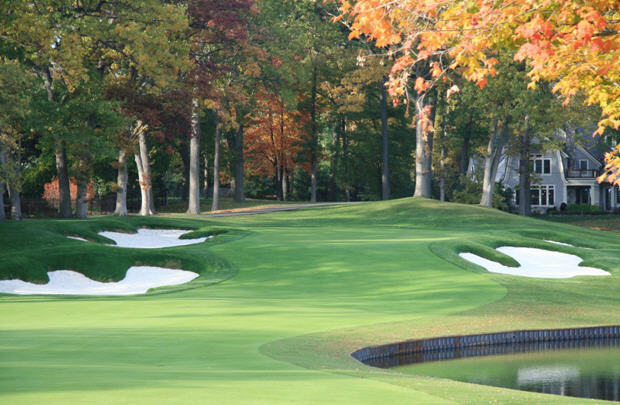
In the spring of 2013, the American golf course design firm, Hills & Forrest, was asked to prepare a Master Plan for renovation and restoration of Oakland Hills Country Club’s North Course. The USGA had announced that Oakland Hills, already host to nine major championships and a Ryder Cup, would host the 2016 US Amateur, an event which requires two courses for the stroke play qualifying rounds. Construction began in the summer and was completed in the late fall. The North Course was ready to re-open in June, 2014.
The Club’s brief to Hills & Forrest had two objectives: first, to “improve the playability of the course for the average member by providing more teeing options and by increasing the size of the landing areas;” and second, in seeming refutation to the first, “to toughen up the course for championships.”
The North Course is the well-respected complement to Oakland Hills’ more famous South course, a Donald Ross design which Robert Trent Jones remodeled prior to the 1950 US Open.
Also designed by Ross, the North, too, was extensively remodeled by Jones in the 1950s and 1960s. Playing to a par of 70, the North had always been appreciated by members for its playability and beauty. And while the Ross routings remained largely intact, the courses were characterized more by the Jones style with dynamic, sand-flashed bunkers and undulating greens.
In addition to rebuilding and squaring up all the tee complexes, Hills & Forrest added over 300 yards to the North Course in anticipation of the powerful games competitors will bring to the 2016 US Amateur. Thirty bunkers (roughly half of the North’s total) were rebuilt and, in some instances, relocated in order both to fit them more comfortably into the natural landforms and to provide a challenge to the longer hitters. The North’s bunkers retain the eclectic style introduced by Trent Jones, with flashed faces and shallow bottoms.
Holes 14 through16 on the North were originally built across a valley covered with a twenty foot layer of peat, an anomaly at Oakland Hills, where sandy soils predominate. Absorbing water when it rained, these peaty soils were springy and unstable, with the grass above very difficult to mow without machines getting stuck. Addressing this drainage problem was a key to the success of the Hills & Forrest master plan.
Hills & Forrest crafted a new pond and sand-capped all the low areas to address the chronic drainage problem in the areas underlain with peat. Multiple drain inlets were added to direct excess water to the pond, whose banks were stabilized by installing a seawall to a depth of 20’ around the perimeter. Part-circle irrigation heads were installed along the perimeter of the fairways to provide more control of the irrigation, allowing the maintenance staff to water the fairways and roughs independently. The fairway on hole #15 received an additional foot of greens-mix (90 % sand and10% organic material) above the sand cap to promote dry conditions.
The modifications recommended by Hills and Forrest created firm and fast playing conditions, echoing the characteristics of the holes built on Oakland Hills’ native sandy soils. The beauty, strategy and playability of hole #15 especially were dramatically improved, and the chronically inferior agronomic conditions in the heavy peat soils were ameliorated. The members instantly appreciated the improvements, giving the work “rave reviews.”
“We accomplished all of our core objections,” according to Club President Michael Hainer. “We now have another gem at Oakland Hills that will make our members proud for years to come.”
Selective tree removal was also undertaken, both to expose the North Course’s picturesque rolling terrain and to accentuate its specimen trees. The Detroit skyline, nearly twenty miles away, is once again visible from the third green.
Steve Cook, Oakland Hills’ Director of Agronomy, added his personal endorsement: “I’ve been doing this for 30 years and I have never heard members so happy with a construction project.”
Hills and Forrest, founded by ASGCA Fellow Arthur Hills in 1966, is one of the oldest continuously operating golf course design firms in the world. Chairman Steve Forrest, a past president of the ASGCA, has managed the company since 1999, overseeing its global expansion and the design of award-winning courses in Sweden, Portugal, Russia, China and Morocco. Hills & Forrest is based in the USA, with satellite offices in Moscow, Russia and Chongqing, China.
Hills & Forrest www.hillsforrest.com
Oakland Hills Country Club www.oaklandhillscc.com

